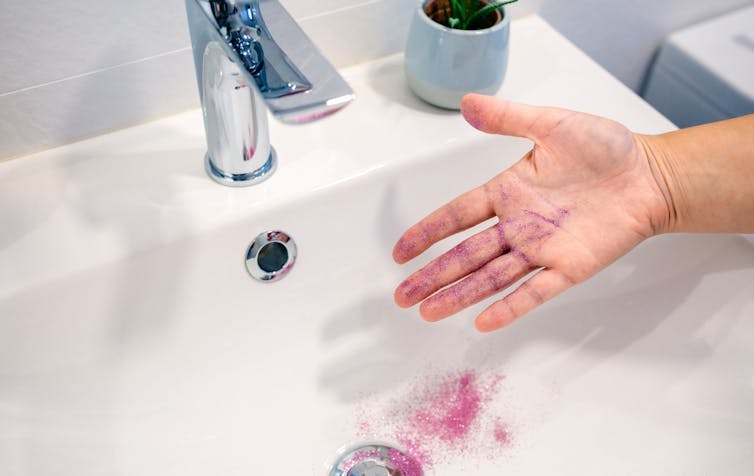A few months ago, shoppers in Germany were reported to have been stockpiling decorative glitter. That’s because it is now officially banned in the EU.
Glitter is made of plastic, and since plastic doesn’t really degrade, almost every bit ever made can still be found somewhere. The glitter you used for your Xmas decorations a decade ago probably still exists. Close to home, it’s likely to be trapped between the fibres of your carpet, wedged between your keyboard or even consumed by your pet or you. Further afield, it may have made its way into the ocean.
Glitter is widely used to decorate clothing, arts and crafts and in cosmetic products. But, let’s call it what it is, beyond the shimmer and the sparkle, glitter is a microplastic.
This means it gets everywhere. But despite it’s glitzy, harmless appearance, it has many adverse impacts. Here are five reasons why you should ditch glitter this Xmas:
1. It prevents recycling
The problem with glitter is that it isn’t biodegradable and is a contaminant. Glitter makes products that you may normally wish to recycle, such as wrapping paper, no longer recyclable.
This is why many councils across the UK have put out guidance on festive waste, reminding households not to put shiny or glittery Christmas cards or wrapping paper in recycling bags. It will contaminate the load and you may run the risk of having your recycling left at your doorstep.

Even if you go for sustainable biodegradable glitter or glittery wrapping paper and so on, there is no way of distinguishing this at the point of recycling. So it’s probably better to go into your general waste rather than recycling bins. Besides, there are concerns “eco-glitter” causes similar damage to our oceans as traditional glitter.
2. Fish think it’s food
Due to its size and scale, lots of plastic glitter will inevitably make its way into water, drains, rivers and eventually the oceans. Marine life often mistakes the floating particles for food, which has been shown to significantly impact the reproduction rates of oysters, while also making other animals less active, less responsive to predator cues, more likely to be eaten and less likely to thrive.

3. Microplastics can harm us too
Microplastics are also increasingly being found inside human bodies. One study estimated that humans ingest or inhale more than 100,000 bits of plastic each day. Eliminating plastic glitter would be one less source of microplastics to worry about.
Glitter is produced through plastics PET or PVC and covered with synthetic materials for its visual shimmer. The substances used to make glitter are known to harm human health.
4. Microplastics work their way up the food chain
Aside from finding its way into your roast turkey from Xmas cards, party crackers and decorative baubles, growing research suggests microplastics ultimately end up back on our dinner tables. It’s consumed by plankton, fish, shellfish, seabirds and other marine life, thus passing through the food chain and eventually reaching us.
Besides, microplastics are like magnets for other toxic pollutants, adding an additional layer of contamination, which may find its way up the food chain, onto our plates.
5. Glitter is so dangerous because it’s so small
Due to its ubiquitous nature and minuscule size, it can be argued that glitter is more dangerous than other members of the microplastics family. Glitter is already a microplastic, making it easier to spread and contaminate our soil, air, water and food. It’s widely accessible, pervasive in nature and washing it down the drain only means it ends up in the ocean.
A study from earlier this year concluded that a few specs of glitter can impede the growth of organisms that play a key role in water and soil cycles.
While restricting glitter is only a minuscule step in addressing the broader microplastics problem, the EU has taken a lead on this, while plastic glitter is still accessible in the UK. Leading UK retailers such as Morrisons should be commended for taking a stance and going completely glitter free.
Banning or at least avoiding glitter obviously won’t save the climate or reverse the extinction crisis. But if we are to protect our planet, no step is too small.

Don’t have time to read about climate change as much as you’d like?
Get a weekly roundup in your inbox instead. Every Wednesday, The Conversation’s environment editor writes Imagine, a short email that goes a little deeper into just one climate issue. Join the 30,000+ readers who’ve subscribed so far.

